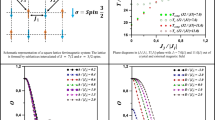Abstract
In many paramagnetic crystals the resonance absorption of microwaves in the presence of a transverse magnetic field spreads over a range of a few hundred gauss, and this can be accounted for by the magnetic interaction between the ions. There are certain substances, however, of which copper sulphate is an example, in which the resonance is sharper than can be explained in this way, and it has been suggested that the sharpness is due to electron exchange1. Gorter and Van Vleck2 have reported the result of a calculation which shows that, while the mean square spread is unaffected by exchange, the mean fourth power spread is increased, indicating a sharpening of the peak together with an enhanced absorption in the wings of the resonance. That such an effect is to be expected can be seen from the following qualitative argument.
Similar content being viewed by others
References
De Klerk, Physica, 12, 513 (1946).
Gorter and Van Vleck, Phys. Rev., 72, 1128 (1947).
Bloembergen, Pound and Purcell, Phys. Rev., 71, 466 (1947).
Bagguley and Griffiths, Nature (preceding communication).
Polder, Physica, 9, 709 (1942).
Krishnan and Mookherji, Phys. Rev., 50, 860 (1936); 54, 533 (1938): 54, 841 (1938).
Opechowski, Physica, 14, 237 (1948).
Author information
Authors and Affiliations
Rights and permissions
About this article
Cite this article
PRYCE, M. Theory. Nature 162, 539–540 (1948). https://doi.org/10.1038/162539a0
Issue Date:
DOI: https://doi.org/10.1038/162539a0
- Springer Nature Limited
This article is cited by
-
Formation of correlated spin systems in one- and two-dimensional copper and lanthanide compounds
Applied Magnetic Resonance (2000)
-
Magnetic resonance in Kazan and in Oxford
Applied Magnetic Resonance (1992)
-
Étude de l'effet faraday paramagnétique (fin)
Annales des Télécommunications (1958)





